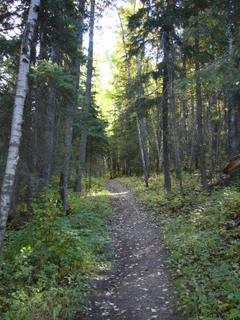Photos, program information, and general insights from the staff of the Kerry Wood Nature Centre.
Saturday, December 31, 2005
Keep Your Eyes Out
There is definitely benefits to keeping an eye out while walking in the Sanctuary. A family has recently sighted a porcupine sleeping in the squirrel tree just ahead of the fork in the trail to the bird blind. She was really high up, a good reminder to look everywhere.. up, down, and all around.
Labels:
animals
Thursday, December 22, 2005
Holiday Fun
The holidays are here and if you are wondering what to do, come to the Nature Centre. Our gallery is displaying one of the most wonderful owl exhibits. Come see if you can guess what each owl sounds like. And the weather is supposed to be beautiful all week so there is no better time to take a walk around the sanctuary. The building hours are as follows:
now to Dec 24: 10:00 a.m. - 5:00 p.m.
Dec 25: closed
Dec 26 and 27: 1:00 p.m. - 5:00 p.m.
Dec 28 to 31 10:00 a.m. - 5:00 p.m.
Jan 1: 1:00 p.m. - 5:00 p.m.
Jan 2: return to normal hours 10:00 a.m. - 5:00 p.m.
Hope to see you and have a good year :)
now to Dec 24: 10:00 a.m. - 5:00 p.m.
Dec 25: closed
Dec 26 and 27: 1:00 p.m. - 5:00 p.m.
Dec 28 to 31 10:00 a.m. - 5:00 p.m.
Jan 1: 1:00 p.m. - 5:00 p.m.
Jan 2: return to normal hours 10:00 a.m. - 5:00 p.m.
Hope to see you and have a good year :)
Labels:
exhibits
Thursday, November 24, 2005
Tuesday, November 08, 2005
Not all evergreens have needles
 Sharp-eyed visitors to the Sanctuary this time of year may notice the occasional patch of plants that hasn't turned brown with the coming of the cold temperatures. In this particular case the plant in question is Pink Wintergreen (Pyrola asarifolia).
Sharp-eyed visitors to the Sanctuary this time of year may notice the occasional patch of plants that hasn't turned brown with the coming of the cold temperatures. In this particular case the plant in question is Pink Wintergreen (Pyrola asarifolia).While this wintergreen isn't the wintergreen used to flavour gums and mints, it has historically been used to ease toothaches, calm sore throats, and even stop or slow down bleeding.
Pink wintergreen can be found on the floor of moist conifer forests in central and northern Alberta. The small, round, leathery leaves appear to grow stemlessly from the ground. As the plant's common name implies, the leaves tend to stay greenish (but tend toward red in the winter) throughout the year. Each plant sends up a flower stalk in early to mid summer. The pink, cup-shaped flowers are attractive but easy to miss amongst the forest floor litter.
Labels:
plants
Thursday, November 03, 2005
On the Wishart Trail

A look at part of the abandoned river channel. Obviously this picture was taken before our recent snowfall...
Labels:
sanctuary
Tuesday, November 01, 2005
Seen in the Sanctuary:

It's not too hard to find moose tracks along the trails at the moment. My foot should give you a sense of the scale of the tracks here (sometimes you just have to work with what you've got...).
Even though we're probably past any dangers from this year's rut, animals in the Sanctuary should always be treated with caution. Wild animals are called wild for a reason, after all.
Labels:
sanctuary
Saturday, October 29, 2005
Wednesday, October 26, 2005
Halloween Party Time
 The Tuesday morning Nature Nursery kids had their Halloween party this week. Spooky games and snacks, costumed kids and a candy-filled, pumpkin-shaped pinata that just wouldn't break.
The Tuesday morning Nature Nursery kids had their Halloween party this week. Spooky games and snacks, costumed kids and a candy-filled, pumpkin-shaped pinata that just wouldn't break.
Labels:
Pre-school
Thursday, October 13, 2005
An evening stroll
Being out with a group of Junior Forest Wardens last night reminded me that this is actually a very nice time of year for an evening walk in the Sanctuary. It's still warm enough to be comfortable, and it doesn't get dark all that early (yet. The end of daylight savings time later this month will change that, unfortunately).
Some of you may not realise it, but the Gaetz Lakes Sanctuary is easily accessible for walks even when the Nature Centre itself is closed. There's a turnstile gate to the north of the building that visitors are more than welcome to use.
Please remember, though, that Sanctuary rules (no running, in-line skating, bikes, or pets) apply to evening strolls as much as they do to daytime ones. As we say in our programs calendar, this is one place where the needs of the wildlife must come first.
Some of you may not realise it, but the Gaetz Lakes Sanctuary is easily accessible for walks even when the Nature Centre itself is closed. There's a turnstile gate to the north of the building that visitors are more than welcome to use.
Please remember, though, that Sanctuary rules (no running, in-line skating, bikes, or pets) apply to evening strolls as much as they do to daytime ones. As we say in our programs calendar, this is one place where the needs of the wildlife must come first.
Labels:
sanctuary
Wednesday, October 12, 2005
Changes: Seasonal and Staff
When I left for my vacation on September 23, the leaves were golden and red and those that had fallen were crunchy under your feet. As I traveled west, returning to the coast and my childhood home, I was reminded that not all places go through such dramatic colour change. Passing across the continental divide and driving through places like Salmon Arm, Hope and finally Vancouver, I found that fall hadn't quite arrived. Deciduous trees in my parents' neighbourhood were still green; just about to change. Lawns were still lush. There was no crunch, crunch, crunch, as the kids walked down the street to school.
When we left on the 9th of October to head home, things were just starting to change. Leaves were changing (to brown instead of orange, yellow and red) and some were starting to fall; often to form damp clumps in the ditches and gutters. Back home in Alberta I found I was happy to see a nice thick coating of brittle leaves from the paper birch in our front yard. All the trees are well on their way to becoming bare and in fact most are now looking nicely ready for winter: Naked branches contrast on bright blue skies. This is the autumn I never had as a kid. I like living in a place that has four definite seasons - even if one of them is blindingly cold.
The onset of a change in seasons has brought about a change in staff as well. Jo-Anne has obtained full-time work with a local properties management company and will be leaving her daytime interpretive work behind her. She will remain with us for weekend and evening programs and visitor services shifts. We wish Jo-Anne the best of luck in her new field. Joining us is Caroline. This transplanted American comes to us fresh from completing her degree in Environmental Policy and an internship at the Thomas Irving Dodge Nature Centre in Minnesota. Welcome aboard Carrie.
For those of you living in Central Alberta, there are still spaces available for Jo-Anne's Winter Camping program on October 22. Call the Nature Centre at 346-2010 or email us for more information.
When we left on the 9th of October to head home, things were just starting to change. Leaves were changing (to brown instead of orange, yellow and red) and some were starting to fall; often to form damp clumps in the ditches and gutters. Back home in Alberta I found I was happy to see a nice thick coating of brittle leaves from the paper birch in our front yard. All the trees are well on their way to becoming bare and in fact most are now looking nicely ready for winter: Naked branches contrast on bright blue skies. This is the autumn I never had as a kid. I like living in a place that has four definite seasons - even if one of them is blindingly cold.
The onset of a change in seasons has brought about a change in staff as well. Jo-Anne has obtained full-time work with a local properties management company and will be leaving her daytime interpretive work behind her. She will remain with us for weekend and evening programs and visitor services shifts. We wish Jo-Anne the best of luck in her new field. Joining us is Caroline. This transplanted American comes to us fresh from completing her degree in Environmental Policy and an internship at the Thomas Irving Dodge Nature Centre in Minnesota. Welcome aboard Carrie.
For those of you living in Central Alberta, there are still spaces available for Jo-Anne's Winter Camping program on October 22. Call the Nature Centre at 346-2010 or email us for more information.
Labels:
staff
Monday, October 03, 2005
Recycling
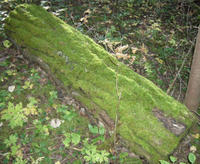 I have to admit that one of my favourite parts of the Sanctuary is the dark forest in the shadow of Michener Hill. Its almost mountain-like feel is a reminder that Red Deer exists in the middle of a real traffic jam of plant communities. In a fairly small area you can find everything from marsh and grassland to full spruce forest.
I have to admit that one of my favourite parts of the Sanctuary is the dark forest in the shadow of Michener Hill. Its almost mountain-like feel is a reminder that Red Deer exists in the middle of a real traffic jam of plant communities. In a fairly small area you can find everything from marsh and grassland to full spruce forest.Our Sanctuary forest contains a fair amount of deadwood, and visitors may occasionally wonder why we don't clear up the mess of fallen trees or at least remove the standing snags.
The fact is that there is a lot of natural recycle value in those dead trees. While standing, they provide homes and feeding spots for all kinds of animal populations; insect, mammal, and avian. Imagine a forest without chickadee nests or woodpecker foraging holes. I don't think it would be nearly as interesting.
Once a tree falls (or often even before), the insects, fungi, and mosses really get to work. As they help break the tree down, its component nutrients are gradually returned to the soil and help provide fertilizer for new plants coming up. If the dead trees were continually removed instead of being allowed to rot naturally, we would eventually end up with sterile, nutrient-poor soil that wouldn't be good for much of anything.
Just a little something to think about the next time you're looking at a mossy log. That's not waste -- it's recycling at its finest.
Labels:
sanctuary
Thursday, September 29, 2005
Squirrel midden

A Red Squirrel midden on the Wishart Trail. Midden is, appropriately, an old word for garbage dump (more or less). Squirrel middens contain the remnants of spruce cones and shells left behind as the squirrel seeks out the seeds enclosed in them. Sometimes squirrels use the middens themselves to burrow in and hide more food.
Scientists occasionally sift through squirrel middens to learn what food resources the squirrels are using over the course of a year.
Tuesday, September 27, 2005
Saturday, September 24, 2005
Geese on the West Gaetz Lake beaver lodge
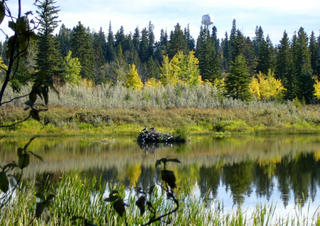
A shot from the Wishart Trail earlier this week. Fall is definitely here -- maybe the water's getting chilly on their feet?
As always, click on the picture for a larger version.
Thursday, September 22, 2005
far away wild
Its interesting comparing the wildlife of eastern Canada to our own back in Red Deer. The cordillera of Ontario was like the Rocky Mountains with out the mountains - just rocks, trees and water. Instead of magpies, there are ravens which called incessantly this morning keeping my friend up. Lots of interesting bird noises which has been referred to as a magpie trying to imitate a flamingo.. doubtful but interesting guess. Instead of dangers of rutting moose, there was a danger of a bear nearby our Ontario campground. And it was neat to see a skunk (striped I think) to cross the road successfully.
Labels:
animals
Tuesday, September 20, 2005
Trail Report 20 Sept 05
It was a nice, quiet morning for a walk so I decided to spent an hour or so out on the Wishart Trail today. Things are certainly well into fall now. Some of the trees are already looking bare, but there is still plenty of colour out there.
Trail conditions are generally pretty good, but keep in mind that the combination of morning dew and fallen leaves can make some of the steeper sections a bit slippery. When in doubt take your time.
As far as animal sightings go, it was mostly a morning for squirrels and robins, with the occasional chickadee or native sparrow thrown in for some variation. The lakes were actually pretty empty today, but I did notice a pair of Canada Geese perched on top of the old beaver lodge on the West Gaetz Lake. Maybe the view's better from there?
As Todd mentioned earlier, please keep an eye open for moose and deer. There are a lot of moose tracks on the trail right now, and since it's rutting season the moose can be fairly unpredictable. Remember to make some noise while you're walking to let the animals know you're out there. Speaking as someone who's been chased by a moose before, let me say that it really isn't the best way to experience nature in the Sanctuary.
Stay safe, and enjoy the fall scenery!
Trail conditions are generally pretty good, but keep in mind that the combination of morning dew and fallen leaves can make some of the steeper sections a bit slippery. When in doubt take your time.
As far as animal sightings go, it was mostly a morning for squirrels and robins, with the occasional chickadee or native sparrow thrown in for some variation. The lakes were actually pretty empty today, but I did notice a pair of Canada Geese perched on top of the old beaver lodge on the West Gaetz Lake. Maybe the view's better from there?
As Todd mentioned earlier, please keep an eye open for moose and deer. There are a lot of moose tracks on the trail right now, and since it's rutting season the moose can be fairly unpredictable. Remember to make some noise while you're walking to let the animals know you're out there. Speaking as someone who's been chased by a moose before, let me say that it really isn't the best way to experience nature in the Sanctuary.
Stay safe, and enjoy the fall scenery!
Labels:
sanctuary
Saturday, September 17, 2005
Seen in the Sanctuary:
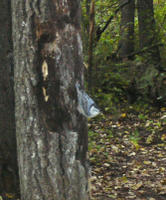 Not the greatest picture since I was using the zoom, but I saw this White-Breasted Nuthatch on a spruce tree on the Wishart Trail last Wednesday. It was obviously trying to pretend I didn't see it if it didn't move.
Not the greatest picture since I was using the zoom, but I saw this White-Breasted Nuthatch on a spruce tree on the Wishart Trail last Wednesday. It was obviously trying to pretend I didn't see it if it didn't move.Nuthatches always seem like they have a different grasp on the whole gravity idea than I do. That much time spent upside down would just give me a headache.
Labels:
animals
Wednesday, September 14, 2005
Love Is In The Air
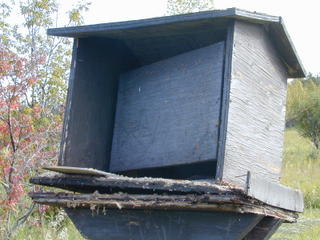
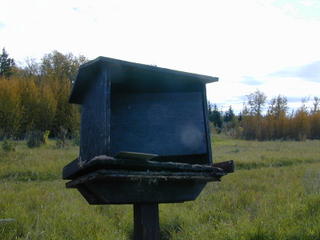
This is what happens to your bird feeders when the local male moose decides to show his girlfriend how tough he is. Imagine the thought process: "I'm the mate for you. Look I've destroyed a helpless bird feeder to prove the fitness of my genes".
On a more serious note, visitors to the Sanctuary should keep in mind that we are at the start of the fall moose rut which means that the local males are defending their territory against anything they perceive to be a threat. If you should encounter a moose (male or female), simply back away quietly; attempting to keep a large object - like a tree - between you and the animal. Do not turn and run away. Moose can run faster than you.
This is a good time of year to actually make noise while you are walking along the City's many trails. It won't help with the males but it will alert the females to your presence.
Labels:
animals
Last of the Butterflies?

This is one of the best butterfly pictures I've seen. How often do you get to look into a butterfly's eye? Click the image to enlarge it. This Painted Lady is not part of the odd migration of these butterflies into our area that took place at the end of June. Rather, because this little critter is in such excellent shape, it probably is an offspring of the summer travelers.
This photo was taken by Diane on an apartment balcony last week. The cool weather slowed the butterfly down so that she was able to get to within inches of it without it flying away.
Labels:
animals
Tuesday, September 13, 2005
Sunday, September 11, 2005
Saturday, September 10, 2005
Nature Nursery News
Nature Nursery has started again. This is an unparented playschool program for 3-5 year olds. We have four classes running:
Tuesday mornings (2 1/2 hours per week)
Tuesday/Thursday afternoons (2 1/2 hours per afternoon - 5 hours per week)
Wednesday/Friday mornings (2 1/2 hours per morning - 5 hours per week)
Wednesday/Friday afternoons. (2 1/2 hours per afternoon - 5 hours per week)
We still have a few spaces left in all but the Tuesday morning classes.
For the week of September 12-16 our themes are "bears" and "migration." The following week we have Erin Young from Medicine River Wildlife Centre visiting the classroom. She will be sharing pictures and a story and bring a wild animal with her (we don't know yet which one she'll bring.)
Duck and Ducklings has also started for the season. This is a adult and tot program for 2-4 year olds. We offer two classes for the Duck and Ducklings, Monday and Thursday mornings. This class runs for 1 1/2 hours from 10-11:30. We will also be doing bears for the week of September 12-16 and squirrels and chipmunks the following week.
This week, the children have been lucky enough to watch mama barn swallow feeding her newly fledged babies at the front door to the Nature Centre. The 4 cuties have been parking themselves on the light outside the front door and will wait patiently for mom to drop a juicy bug into their mouth.
Tuesday mornings (2 1/2 hours per week)
Tuesday/Thursday afternoons (2 1/2 hours per afternoon - 5 hours per week)
Wednesday/Friday mornings (2 1/2 hours per morning - 5 hours per week)
Wednesday/Friday afternoons. (2 1/2 hours per afternoon - 5 hours per week)
We still have a few spaces left in all but the Tuesday morning classes.
For the week of September 12-16 our themes are "bears" and "migration." The following week we have Erin Young from Medicine River Wildlife Centre visiting the classroom. She will be sharing pictures and a story and bring a wild animal with her (we don't know yet which one she'll bring.)
Duck and Ducklings has also started for the season. This is a adult and tot program for 2-4 year olds. We offer two classes for the Duck and Ducklings, Monday and Thursday mornings. This class runs for 1 1/2 hours from 10-11:30. We will also be doing bears for the week of September 12-16 and squirrels and chipmunks the following week.
This week, the children have been lucky enough to watch mama barn swallow feeding her newly fledged babies at the front door to the Nature Centre. The 4 cuties have been parking themselves on the light outside the front door and will wait patiently for mom to drop a juicy bug into their mouth.
Labels:
Pre-school
Thursday, September 08, 2005
Down the ACR Trail
Gee, spring a person from the office and she actually gets out and walks now and then...
Today I took a stroll on the ACR Trail, which is down the hill from the hospital and loosely follows the old CP Rail right-of-way. The trail is probably best known as a short-cut used by RDC students on their way to and from school, but if you're out there during classes when the college traffic slows down it makes a decent short walk (barely 2 km, but keep in mind that it's not a loop). It's not the quietest trail in Red Deer since it does parallel Taylor Drive, but judging from the activity that was going on this morning the birds don't mind the traffic noise at all.
One of the most striking things I noticed on the trail was that Waskasoo Creek is still flowing quite freely. Normally the creek is very sluggish this time of year, but with all the rain we've had lately it's looking surprisingly healthy right now. I'd say that the robins, sparrows, and other song birds are enjoying the extra water. I stood on one of the bridges for a while and watched several of them using a quieter spot as a natural bird bath. Quite the production.
And, really, a neat thing to be watching in the middle of a busy city. Red Deer's trails are one of the city's greatest assets. Be sure to get out and appreciate them!
Today I took a stroll on the ACR Trail, which is down the hill from the hospital and loosely follows the old CP Rail right-of-way. The trail is probably best known as a short-cut used by RDC students on their way to and from school, but if you're out there during classes when the college traffic slows down it makes a decent short walk (barely 2 km, but keep in mind that it's not a loop). It's not the quietest trail in Red Deer since it does parallel Taylor Drive, but judging from the activity that was going on this morning the birds don't mind the traffic noise at all.
One of the most striking things I noticed on the trail was that Waskasoo Creek is still flowing quite freely. Normally the creek is very sluggish this time of year, but with all the rain we've had lately it's looking surprisingly healthy right now. I'd say that the robins, sparrows, and other song birds are enjoying the extra water. I stood on one of the bridges for a while and watched several of them using a quieter spot as a natural bird bath. Quite the production.
And, really, a neat thing to be watching in the middle of a busy city. Red Deer's trails are one of the city's greatest assets. Be sure to get out and appreciate them!
Labels:
plants
Wednesday, September 07, 2005
Trail report 7 Sept 05
Todd and I finally had a chance to get out of the office and around the Wishart Trail this morning. Conditions are good overall, although there's a little bit of gullying on some of the steeper trail sections because of all the rain we've had this year. Nothing serious or impassable, though.
We're starting to see some real fall colour in the leaves now, and the cooler mornings mean the mosquitoes aren't nearly as bad in the shadier areas as they were this summer. Look for plenty of Painted Lady Butterflies (these would be the second generation ones, not the ones we saw migrate here earlier in the season) and dragonflies.
There are still a few ducks out on the lakes, but they're definitely showing fall plumage now.
You'll probably notice that we have a bumper crop of Red Squirrels this year. It makes for some interesting viewing down in the spruces. These squirrels are highly territorial, and when there are so many that need territories it leads to a lot of chattering and chasing up and down the trees.
Overall, it's a great time of year for a walk. I hope to see many of you out on the trails.
We're starting to see some real fall colour in the leaves now, and the cooler mornings mean the mosquitoes aren't nearly as bad in the shadier areas as they were this summer. Look for plenty of Painted Lady Butterflies (these would be the second generation ones, not the ones we saw migrate here earlier in the season) and dragonflies.
There are still a few ducks out on the lakes, but they're definitely showing fall plumage now.
You'll probably notice that we have a bumper crop of Red Squirrels this year. It makes for some interesting viewing down in the spruces. These squirrels are highly territorial, and when there are so many that need territories it leads to a lot of chattering and chasing up and down the trees.
Overall, it's a great time of year for a walk. I hope to see many of you out on the trails.
Labels:
sanctuary
Tuesday, September 06, 2005
Fun with camouflage

If you look closely you should be able to see one of the (many) grasshoppers out in the grassland. Obviously our spring fire didn't affect that particular population much...
Labels:
animals
Thursday, September 01, 2005
Fire leftovers
 Those of you who've walked the Dr. George trail at all this summer may have noticed that a few of the spruce trees appear to be dead or have dying limbs like the tree on the left (as always, click on the photo to make it larger). This is one of the few visible reminders of our prescribed burn in the grassland this spring.
Those of you who've walked the Dr. George trail at all this summer may have noticed that a few of the spruce trees appear to be dead or have dying limbs like the tree on the left (as always, click on the photo to make it larger). This is one of the few visible reminders of our prescribed burn in the grassland this spring.While deciduous trees tend to be fairly tolerant of fast-moving fires before they get their leaves, spruces and other conifers (which don't drop their needle-shaped leaves in the fall) are much more affected by the heat and smoke and will sometimes even be killed by it. One of the many reasons for having a prescribed burn in the Sanctuary was to help slow the encroachment of these trees into the former pasture area.
That was a bit of a roundabout way of saying "we meant to do that."
Just as an aside, the red, dying needles on the affected trees are also a good reminder that your backyard spruces and your backyard fire pit aren't a very good match. For general safety and for the sake of your trees' health, it's always a good idea to keep fire pits well away from overhanging branches.
Labels:
plants
Wednesday, August 31, 2005
Gardening reminder:
For all the gardeners out there, don't forget that the Garden Club will be holding its fall Perennial Plant Exchange at the Nature Centre on Saturday, 10 September 2005 this year. From 1:00 p.m. to 2:00 p.m. you can take home one new plant for every two you bring in. For those who are interested in buying without exchanging, open sales go after 2:00 p.m.
If you are planning to bring plants in, remember to make sure they are well potted and labelled. Also, please inform the Garden Club members when you drop off your plants if your yard has problems such as dew worms.
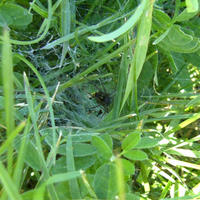 I'll leave you with a look at a Grass Spider (Agelena naevia... or Agelenopsis, depending on the source you check) I saw in the Sanctuary the other day. Grass Spiders are funnel web weavers. They make trampoline-like webs that end with a funnel-shaped opening. The spider waits in the funnel's hole, and when it feels the vibration of an insect on the web it races up and grabs it. As the name implies, Grass Spiders are usually found in grassy fields but can also be seen in hedges and other vegetation occasionally.
I'll leave you with a look at a Grass Spider (Agelena naevia... or Agelenopsis, depending on the source you check) I saw in the Sanctuary the other day. Grass Spiders are funnel web weavers. They make trampoline-like webs that end with a funnel-shaped opening. The spider waits in the funnel's hole, and when it feels the vibration of an insect on the web it races up and grabs it. As the name implies, Grass Spiders are usually found in grassy fields but can also be seen in hedges and other vegetation occasionally.
If you are planning to bring plants in, remember to make sure they are well potted and labelled. Also, please inform the Garden Club members when you drop off your plants if your yard has problems such as dew worms.
 I'll leave you with a look at a Grass Spider (Agelena naevia... or Agelenopsis, depending on the source you check) I saw in the Sanctuary the other day. Grass Spiders are funnel web weavers. They make trampoline-like webs that end with a funnel-shaped opening. The spider waits in the funnel's hole, and when it feels the vibration of an insect on the web it races up and grabs it. As the name implies, Grass Spiders are usually found in grassy fields but can also be seen in hedges and other vegetation occasionally.
I'll leave you with a look at a Grass Spider (Agelena naevia... or Agelenopsis, depending on the source you check) I saw in the Sanctuary the other day. Grass Spiders are funnel web weavers. They make trampoline-like webs that end with a funnel-shaped opening. The spider waits in the funnel's hole, and when it feels the vibration of an insect on the web it races up and grabs it. As the name implies, Grass Spiders are usually found in grassy fields but can also be seen in hedges and other vegetation occasionally.
Labels:
animals,
plants,
programs and events
Tuesday, August 30, 2005
Hmmm. Stinky?
Those of you who have been out for a walk to the deck on the West Lake lately have probably noticed a bit of an odd, sweatsock-like smell in the air. The culprit, believe it or not, is a ripening berry.
 Low Bush-Cranberry (Viburnum edule), pictured here, and to a lesser extent its cousin High Bush-Cranberry (Viburnum opulus) (below) have a sneaky way of spreading their seeds. As the berries ripen they give off a scent resembling old meat. This attracts scavenging animals, which eat the smelly berries. Sounds weird so far, but it makes sense when you know that the seed inside each berry is tough enough to make it through an animal's digestive system without being destroyed. By the time the seed finally hits the ground it's likely been spread far from the parent plant, and as a bonus it's been planted in a bit of... fertilizer for good measure.
Low Bush-Cranberry (Viburnum edule), pictured here, and to a lesser extent its cousin High Bush-Cranberry (Viburnum opulus) (below) have a sneaky way of spreading their seeds. As the berries ripen they give off a scent resembling old meat. This attracts scavenging animals, which eat the smelly berries. Sounds weird so far, but it makes sense when you know that the seed inside each berry is tough enough to make it through an animal's digestive system without being destroyed. By the time the seed finally hits the ground it's likely been spread far from the parent plant, and as a bonus it's been planted in a bit of... fertilizer for good measure.
 Bush-cranberries, whose berries are edible (if acidic) and make a pretty good preserve, can be identified by their three-lobed leaves (shallow lobes on Low Bush-Cranberry; deeper lobes on High Bush-Cranberry). Low Bush-Cranberry often grows in moist thickets and wetland margins. High Bush-Cranberry can be found bordering poplar stands and in river valleys.
Bush-cranberries, whose berries are edible (if acidic) and make a pretty good preserve, can be identified by their three-lobed leaves (shallow lobes on Low Bush-Cranberry; deeper lobes on High Bush-Cranberry). Low Bush-Cranberry often grows in moist thickets and wetland margins. High Bush-Cranberry can be found bordering poplar stands and in river valleys.
 Low Bush-Cranberry (Viburnum edule), pictured here, and to a lesser extent its cousin High Bush-Cranberry (Viburnum opulus) (below) have a sneaky way of spreading their seeds. As the berries ripen they give off a scent resembling old meat. This attracts scavenging animals, which eat the smelly berries. Sounds weird so far, but it makes sense when you know that the seed inside each berry is tough enough to make it through an animal's digestive system without being destroyed. By the time the seed finally hits the ground it's likely been spread far from the parent plant, and as a bonus it's been planted in a bit of... fertilizer for good measure.
Low Bush-Cranberry (Viburnum edule), pictured here, and to a lesser extent its cousin High Bush-Cranberry (Viburnum opulus) (below) have a sneaky way of spreading their seeds. As the berries ripen they give off a scent resembling old meat. This attracts scavenging animals, which eat the smelly berries. Sounds weird so far, but it makes sense when you know that the seed inside each berry is tough enough to make it through an animal's digestive system without being destroyed. By the time the seed finally hits the ground it's likely been spread far from the parent plant, and as a bonus it's been planted in a bit of... fertilizer for good measure. Bush-cranberries, whose berries are edible (if acidic) and make a pretty good preserve, can be identified by their three-lobed leaves (shallow lobes on Low Bush-Cranberry; deeper lobes on High Bush-Cranberry). Low Bush-Cranberry often grows in moist thickets and wetland margins. High Bush-Cranberry can be found bordering poplar stands and in river valleys.
Bush-cranberries, whose berries are edible (if acidic) and make a pretty good preserve, can be identified by their three-lobed leaves (shallow lobes on Low Bush-Cranberry; deeper lobes on High Bush-Cranberry). Low Bush-Cranberry often grows in moist thickets and wetland margins. High Bush-Cranberry can be found bordering poplar stands and in river valleys.
Labels:
plants
Monday, August 29, 2005
Seen in the Sanctuary:

Wasps, flies, and a few other flower-dependent insects are busy in the Canada Goldenrod. Seems early to say this, but the late season flowers tell me that autumn is already creeping in on us.
Friday, August 26, 2005
A Note About Wasps
Yes, there does appear to be a greater number of wasps (yellow jackets) around this year than in past years. They are easily identifiable by their bright yellow and black striped abdomen. Here is a picture from the Royal Alberta Museum bug room.
Having received a sting on the lip this summer, I can assure you that it will hurt. For most people who don't have an immediate serious reaction, a rapid application of ice to the sting site should take down swelling and pain.
When children get stung - as my fifteen month old did last night - do not apply ice directly to fingertips or toes. Hold a cool, moist cloth on the sting site or put a toy in the bottom of a bowl of cool water and encourage the child to play with it. Ice on infant and toddler fingertips and toes can quickly lead to frostbite.
If you plan on being outside and want to limit your exposure to these insects, the best thing you can do is try to lure them away from you. My wasp lure is a mixture of stale beer, fruit punch and flat soda pop. Mix about a cup's worth and pour it into an empty 4 litre milk jug. Place the jug away from you. The wasps, attracted to the sweet mix, fly in and then due to the smooth walls and narrow top, cannot escape. Last weekend we counted 12 dead wasps in the jug in under two hours. I should point out that while they are annoying, yellow jackets do fill an ecological niche by scavenging dead insects and preying on other insects that people consider to be pests. Yes, even the nasty yellow jacket has a benefit to you. For this reason I'd strongly encourage you to use these lures on a limited basis and only when you are eating and drinking in problem areas.
Another interesting idea is to inflate a lunch-sized, paper bag and seal the top with string. Hang it near you. Supposedly it resembles a nest well enough that the yellow jackets leave it alone. I have not tried this and cannot attest to its effectiveness. If you want to try it out, drop us a line and let us know how it worked.
Having received a sting on the lip this summer, I can assure you that it will hurt. For most people who don't have an immediate serious reaction, a rapid application of ice to the sting site should take down swelling and pain.
When children get stung - as my fifteen month old did last night - do not apply ice directly to fingertips or toes. Hold a cool, moist cloth on the sting site or put a toy in the bottom of a bowl of cool water and encourage the child to play with it. Ice on infant and toddler fingertips and toes can quickly lead to frostbite.
If you plan on being outside and want to limit your exposure to these insects, the best thing you can do is try to lure them away from you. My wasp lure is a mixture of stale beer, fruit punch and flat soda pop. Mix about a cup's worth and pour it into an empty 4 litre milk jug. Place the jug away from you. The wasps, attracted to the sweet mix, fly in and then due to the smooth walls and narrow top, cannot escape. Last weekend we counted 12 dead wasps in the jug in under two hours. I should point out that while they are annoying, yellow jackets do fill an ecological niche by scavenging dead insects and preying on other insects that people consider to be pests. Yes, even the nasty yellow jacket has a benefit to you. For this reason I'd strongly encourage you to use these lures on a limited basis and only when you are eating and drinking in problem areas.
Another interesting idea is to inflate a lunch-sized, paper bag and seal the top with string. Hang it near you. Supposedly it resembles a nest well enough that the yellow jackets leave it alone. I have not tried this and cannot attest to its effectiveness. If you want to try it out, drop us a line and let us know how it worked.
Labels:
animals
Thursday, August 25, 2005
Wednesday, August 24, 2005
West Gaetz Lake, last Friday afternoon
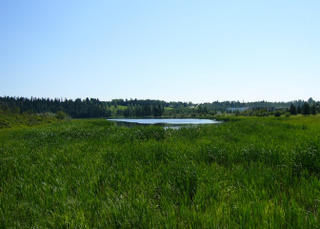
Considering our lovely weather today, I thought it might be nice to remind everyone that we did have sunshine for one or two days last week...
The interesting thing to me about this picture is that if I'd been standing there a few centuries or so earlier, I'd have been standing in the middle of the Red Deer River.
The Gaetz Lakes are remnants of an old bend of the river that was abandoned when the river cut its present channel. Oxbow lakes, as these remnants are called, usually dry up over time, but the springs coming out of Michener Hill have kept the Gaetz Lakes going for a while longer than they might have otherwise.
Shallow oxbow lakes create perfect nesting habitat for large numbers of water birds, and the Gaetz Lakes are the reason why the Sanctuary become Alberta's first federal migratory waterfowl sanctuary back in 1924.
Labels:
sanctuary
Tuesday, August 23, 2005
Nutting
I found myself doing some casual grazing on the weekend. You see, we're heading into nut season in Central Alberta. Yes, we do have naturally occurring nut trees (or shrubs, rather) here, although they seem to be a bit of a surprise even to long-time residents of the area.
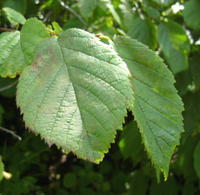 Beaked Hazelnut (Corylus cornuta) is a fairly common understory plant in the Aspen Parkland, but it's more common slightly north of us than it is here in Red Deer. It grows one to three metres tall and has elliptic, toothed leaves (click on the photo to make it bigger) that may remind you of an alder. Hazelnut leaves tend to be slightly larger than those of the alder, though (4 - 10 cm).
Beaked Hazelnut (Corylus cornuta) is a fairly common understory plant in the Aspen Parkland, but it's more common slightly north of us than it is here in Red Deer. It grows one to three metres tall and has elliptic, toothed leaves (click on the photo to make it bigger) that may remind you of an alder. Hazelnut leaves tend to be slightly larger than those of the alder, though (4 - 10 cm).
I'd guess that one of the reasons Beaked Hazelnut isn't better known is that the nuts aren't in plain sight.
 The fruits grow in pairs (though often, as here, one of the pair doesn't fully develop) and hide in long, beaky-looking bracts that give the plant its common name. These bracts are covered in small, prickly hairs, and that can make collecting the nuts a bit of a challenge. You might want to wear gloves if you have sensitive skin.
The fruits grow in pairs (though often, as here, one of the pair doesn't fully develop) and hide in long, beaky-looking bracts that give the plant its common name. These bracts are covered in small, prickly hairs, and that can make collecting the nuts a bit of a challenge. You might want to wear gloves if you have sensitive skin.
Once you strip off the bract you find that the actual nut looks very much like the familiar Christmas hazelnut.
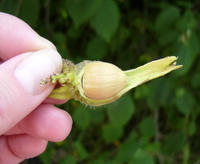 It's a fair bit smaller than its cousin, as you can see here, but every bit as edible. It's possible to roast wild hazelnuts, but I prefer to snack as I go. The thin shells are easily cracked, and the small kernel is pretty tasty.
It's a fair bit smaller than its cousin, as you can see here, but every bit as edible. It's possible to roast wild hazelnuts, but I prefer to snack as I go. The thin shells are easily cracked, and the small kernel is pretty tasty.
You can tell by the still-green bracts in the pictures that the hazelnuts aren't quite fully ripe yet. The main problem with collecting wild hazelnuts is that it gets much harder to find them as they ripen. The covering bracts turn brown like dead leaves, and when the nuts fall off the bush they become almost invisible on the forest floor.
The other reason that ripe nuts are hard to find is that they're a favourite food of many birds and rodents. It can be hard to get much of a supply when you're trying to compete with the Blue Jays and the Red Squirrels.
As always, when looking for wild foods be sure the area you're collecting in hasn't been treated with pesticides or other chemicals. Never collect in protected areas, and never eat anything unless you're absolutely sure you've identified it correctly.
Happy grazing!
 Beaked Hazelnut (Corylus cornuta) is a fairly common understory plant in the Aspen Parkland, but it's more common slightly north of us than it is here in Red Deer. It grows one to three metres tall and has elliptic, toothed leaves (click on the photo to make it bigger) that may remind you of an alder. Hazelnut leaves tend to be slightly larger than those of the alder, though (4 - 10 cm).
Beaked Hazelnut (Corylus cornuta) is a fairly common understory plant in the Aspen Parkland, but it's more common slightly north of us than it is here in Red Deer. It grows one to three metres tall and has elliptic, toothed leaves (click on the photo to make it bigger) that may remind you of an alder. Hazelnut leaves tend to be slightly larger than those of the alder, though (4 - 10 cm).I'd guess that one of the reasons Beaked Hazelnut isn't better known is that the nuts aren't in plain sight.
 The fruits grow in pairs (though often, as here, one of the pair doesn't fully develop) and hide in long, beaky-looking bracts that give the plant its common name. These bracts are covered in small, prickly hairs, and that can make collecting the nuts a bit of a challenge. You might want to wear gloves if you have sensitive skin.
The fruits grow in pairs (though often, as here, one of the pair doesn't fully develop) and hide in long, beaky-looking bracts that give the plant its common name. These bracts are covered in small, prickly hairs, and that can make collecting the nuts a bit of a challenge. You might want to wear gloves if you have sensitive skin.Once you strip off the bract you find that the actual nut looks very much like the familiar Christmas hazelnut.
 It's a fair bit smaller than its cousin, as you can see here, but every bit as edible. It's possible to roast wild hazelnuts, but I prefer to snack as I go. The thin shells are easily cracked, and the small kernel is pretty tasty.
It's a fair bit smaller than its cousin, as you can see here, but every bit as edible. It's possible to roast wild hazelnuts, but I prefer to snack as I go. The thin shells are easily cracked, and the small kernel is pretty tasty.You can tell by the still-green bracts in the pictures that the hazelnuts aren't quite fully ripe yet. The main problem with collecting wild hazelnuts is that it gets much harder to find them as they ripen. The covering bracts turn brown like dead leaves, and when the nuts fall off the bush they become almost invisible on the forest floor.
The other reason that ripe nuts are hard to find is that they're a favourite food of many birds and rodents. It can be hard to get much of a supply when you're trying to compete with the Blue Jays and the Red Squirrels.
As always, when looking for wild foods be sure the area you're collecting in hasn't been treated with pesticides or other chemicals. Never collect in protected areas, and never eat anything unless you're absolutely sure you've identified it correctly.
Happy grazing!
Labels:
plants
Monday, August 22, 2005
Seen in the Sanctuary:

I caught a good look at this dragonfly as it sunned itself on a wild rose bush on Friday. Since I don't know much about dragonflies beyond telling the difference between them and damselflies, any guess at its species would be a completely blind stab. Anyone with more accurate knowledge is welcome to identify it for me by using the comments link below this post.
I could have wished for the sake of the photo that it had been blue or brown rather than yellow (it blends in with the background a bit too well), but you take what you see in front of you at the time. Sometimes nature just doesn't see fit to cooperate!
Incidentally, did you know that dragonflies spend a large part of their life cycles in water? We find the nymphs or naiads quite often when we do pond studies in the spring.
Labels:
animals
Wednesday, August 17, 2005
'Tis the season
For spider questions, that is. Many of the female spiders are becoming larger and more obvious as they prepare to lay eggs, and this leads to an increase in spider calls to the nature centre.
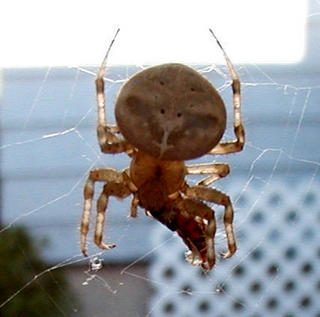
We usually get the most calls about this particular species. It's a Jewel Spider or Jewelled Araneus (Araneus gemmoides), and it's one of the biggest spiders in Alberta. The abdomen of a female can easily be as large as the tip of your thumb.
Jewel Spiders are most easily identified by their size and the two large bumps on the top of the abdomen. They're sometimes known as Cat Spiders, since some people see the image of a cat's face in the abdomen's patterns.
Jewel Spiders are in the orb weaver group, which means they build a classic flat web. The webs are often found in areas that get evening light, like a porch or window frame. Moths and other insects attracted to the light end up getting trapped in the orb web. A pretty neat hunting trick.
If you find a Jewel Spider on or near your home, the most important thing to remember is that they're actually quite harmless to humans. In fact, they're fairly shy and will do their best to retreat as long as they're given the opportunity. When you stop to think about it, spiders like this are doing us a service by keeping the local insect population in check.
For more information on this and other local spider species, look for Marianne and the Kerry Wood Nature Centre's display at the flower show at Parkland Nurseries on Saturday, 20 August 2005.

We usually get the most calls about this particular species. It's a Jewel Spider or Jewelled Araneus (Araneus gemmoides), and it's one of the biggest spiders in Alberta. The abdomen of a female can easily be as large as the tip of your thumb.
Jewel Spiders are most easily identified by their size and the two large bumps on the top of the abdomen. They're sometimes known as Cat Spiders, since some people see the image of a cat's face in the abdomen's patterns.
Jewel Spiders are in the orb weaver group, which means they build a classic flat web. The webs are often found in areas that get evening light, like a porch or window frame. Moths and other insects attracted to the light end up getting trapped in the orb web. A pretty neat hunting trick.
If you find a Jewel Spider on or near your home, the most important thing to remember is that they're actually quite harmless to humans. In fact, they're fairly shy and will do their best to retreat as long as they're given the opportunity. When you stop to think about it, spiders like this are doing us a service by keeping the local insect population in check.
For more information on this and other local spider species, look for Marianne and the Kerry Wood Nature Centre's display at the flower show at Parkland Nurseries on Saturday, 20 August 2005.
Labels:
animals
Tuesday, August 16, 2005
Oh. Deer!
So long as we're introducing ourselves, hello. My name is Todd. I'm the Programs Coordinator for the Waskasoo Park Interpretive Program. It's been an exciting summer around here with day camps, summer programs, a new Executive Director and some upcoming intiatives that have been keeping us quite busy.
Some days, nature decides to be spectacular:
No sooner do I finish mentioning to a lovely couple from England, that while there has been a female White-tailed deer with fawns in the Sanctuary but they've been pretty secretive than the husband says "Is that them?"
I look over my shoulder and out the window and the mother is not ten feet from our dogwood bushes.
It was a bright moment in an otherwise grey, drizzly day.
Some days, nature decides to be spectacular:
No sooner do I finish mentioning to a lovely couple from England, that while there has been a female White-tailed deer with fawns in the Sanctuary but they've been pretty secretive than the husband says "Is that them?"
I look over my shoulder and out the window and the mother is not ten feet from our dogwood bushes.
It was a bright moment in an otherwise grey, drizzly day.
Welcome to the Nature Centre's staff blog
Hi and welcome to the blog, everyone. We hope to use this space to keep you up to date on current sightings in the Gaetz Lakes Sanctuary as well as upcoming programs at the Kerry Wood Nature Centre and Historic Fort Normandeau.
For those who might be unfamiliar with the format of a blog (short for weblog), you'll always find the most current entry at the top of the page. Earlier entries will stay on the main page for a short while, but if you're looking for something that seems to have gone missing try using the archives links to your right.
This blog will be developing bit by bit over the next couple of weeks. Check back often for updates or new features.
I'd expect that our contributors will each introduce themselves as they come online, but since I'm first we'll start with me. I'm the Senior Interpreter for the Waskasoo Park Interpretive Program. You'll usually find me working with school and youth groups, answering natural history questions, or leading public programs. For more on my background check out the staff profile link on the Waskasoo Park home page.
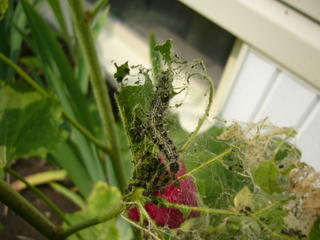 I'll leave you with a look at what is likely a leftover from the Painted Lady Butterfly invasion we had earlier in the year. This little guy probably won't make it through an Alberta winter, though. Click on the picture to make it larger.
I'll leave you with a look at what is likely a leftover from the Painted Lady Butterfly invasion we had earlier in the year. This little guy probably won't make it through an Alberta winter, though. Click on the picture to make it larger.
See you around the blog!
For those who might be unfamiliar with the format of a blog (short for weblog), you'll always find the most current entry at the top of the page. Earlier entries will stay on the main page for a short while, but if you're looking for something that seems to have gone missing try using the archives links to your right.
This blog will be developing bit by bit over the next couple of weeks. Check back often for updates or new features.
I'd expect that our contributors will each introduce themselves as they come online, but since I'm first we'll start with me. I'm the Senior Interpreter for the Waskasoo Park Interpretive Program. You'll usually find me working with school and youth groups, answering natural history questions, or leading public programs. For more on my background check out the staff profile link on the Waskasoo Park home page.
 I'll leave you with a look at what is likely a leftover from the Painted Lady Butterfly invasion we had earlier in the year. This little guy probably won't make it through an Alberta winter, though. Click on the picture to make it larger.
I'll leave you with a look at what is likely a leftover from the Painted Lady Butterfly invasion we had earlier in the year. This little guy probably won't make it through an Alberta winter, though. Click on the picture to make it larger.See you around the blog!
Subscribe to:
Posts (Atom)


